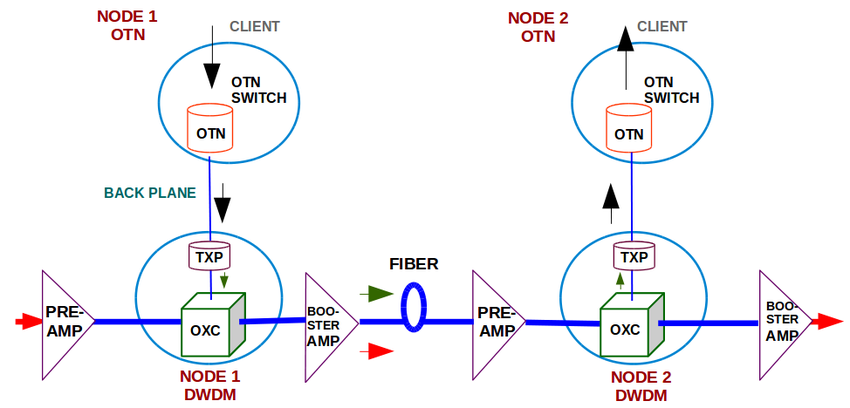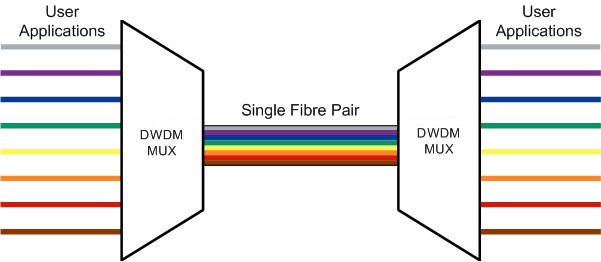Compare difference: DWDM vs. OTN
At present, DWDM (Dense Wavelength Division Multiplexing) and OTN (Optical Transport Network) technologies are widely used in network communication construction. DWDM technology greatly improves the transmission capacity of optical fiber networks, but it is insufficient in optical domain signal processing and service cheduling. , Unable to meet the high standards of broadband data services. As an evolution product of DWDM technology, OTN has a variety of customer signal encapsulation and transparent transmission, large-particle bandwidth multiplexing, flexible crossover and configuration scheduling, strong overhead and maintenance management capabilities, while enhancing networking and protection capabilities.The unique advantages of the equipment have gradually replaced DWDM equipment. What is the difference between DWDM and OTN?

What is DWDM?
DWDM represents Dense Wavelength Division Multiplexing. It is a technology in which several optical signals (laser light) of multiple wavelengths or colors are combined into one signal and are sent over the connecting channel to a lengthy area.
When the optical signal transmission distance changes into thousands of kilometers, it results in loss of few signals. It can satisfy this signal loss, optical fibre amplifiers are used in the DWDM transmission system.
The DWDM technology requires this gain bandwidth to send multiple optical signals together effectively. DWDM can address up to 80 channels (80 optical signals) with 100 GHz (0.8 nm) spacing.
Dense Wavelength Division Multiplexing (DWDM) is an optical multiplexing technology that can enhance bandwidth over current fibre networks. DWDM task operates by joining and transmitting several signals concurrently at multiple wavelengths on the same fibre. The technology generates several virtual fibres, therefore magnifying the capacity of the physical channel.
DWDM is treated as one of the best technologies to increase bandwidth over a current fibre plant. It allows one to generate several “virtual fibres” over one physical fibre. It does this by transmitting several wavelengths (or colors) of light down a bit of fibre.
DWDM was originally adopted by high distance carriers because the spending in amplification, dispersion compensation, and regeneration collected most of the network supplied cost in regional and national SONET networks. DWDM became increasingly famous in metro networks when the local exchange carriers produced their networks.
What is OTN?
OTN represents the Optical Transport Network. It is a transmission network that constructs networks in the optical layer based on wavelength division multiplexing technology and is the next generation backbone transmission network.
The OTN switching structure is combined in the technology, therefore that the system can flexibly dispatch connection services so that the client data can be expanded, promoted, increased, and the network connection service capability is increased, thereby solving the traditional WDM network without wavelength/sub-wavelength.
The OTN network has enhanced the perfect solution for the large-bandwidth granular service. The OTN network is set up in the inter-provincial backbone network, the provincial backbone network, and the metro element layer of the telecom functions and the scheduling of function particles above Gb/s is supported. The provincial backbone network carries long-distance services including PSTN/2G/3G/4G/internet.
The OTN network can execute several forms of protection and has powerful protection capabilities. The backbone network in the province carries services such as the NGW/3G/4G/IPTV large user line between the backbone routers. The metro element network carries the huge granular service among the local network core router and the aggregation router and constructs the provincial backbone network OTN and the metropolitan area network core layer OTN network.
The conceptual difference between DWDM and OTN
DWDM: Dense Wavelength Division Multiplexing (DWDM: Dense Wavelength Division Multiplexing) is near the window with a wavelength of 1550nm, within the range that EDFA can provide gain, combining multiple light waves into a group of light wavelengths and transmitting it with a single fiber Laser technology to increase bandwidth on the fiber backbone. More precisely, the technique is to multiplex the close spectral spacing of a single fiber carrier in a designated fiber in order to utilize the achievable transmission performance (for example, to achieve the smallest degree of dispersion or attenuation). In this way, under a given information transmission capacity, the total number of optical fibers required can be reduced.
OTN (Optical Transport Network) is a transmission network based on wavelength division multiplexing technology and organizing the network at the optical layer. It is the next generation backbone transmission network. The OTN switching module is added to the technology, so that the system can flexibly schedule communication services, expand, promote, and increase client information, and improve the network communication service capabilities, thereby solving the traditional WDM network without wavelength / sub-wavelength Problems such as poor service scheduling capabilities, weak networking capabilities, and weak protection capabilities.
DWDM and OTN :
| DWDM | OTN |
| DWDM is WDM utilizing closely spaced channels. | OTN is asynchronous mapping of payloads. |
| The networking mode of DWDM is basically point-to-point, chain, star and ring networking. | The networking mode of OTN is usually a ring network, mesh network and other networking modes |
| This is basically a technology . | This is the complete set which involves DWDM technology with Manageability features added to it (DWDM) . |
| It is mainly used in inter provincial trunk network and intra provincial backbone network. | It provides a very ideal solution for large broadband granular services. |
| Its main component are multiplexer, demultiplexer, amplifier and ROADM. | It is collection of optical cross-connector (OXC) and optical add/drop multiplexer (OADM), possesses functions like optical cross-ability and wavelength conversion. |
| It is applied in fiber optical transceiver to increase bandwidth over existing fiber optic backbones. | It can provide functionality of transport, management, supervision, multiplexing, routing and survivability of optical channels carrying client signals. |
| It features include transparency, dynamic provisioning and scalability. | It adds features like fault detection, performance monitoring, communication channels, and multiplexing hierarchy to WDM equipment. v |
Different signal formats
DWDM technology has no corresponding frame structure. During operation, the wavelength of a single signal is converted into a wavelength corresponding to the network communication through a converter, and the transmission wavelength is multiplexed through optical technology.
OTN has a complete frame mechanism. Scheduling wavelengths through electrical cross technology can achieve SDH-like electrical cross function, so that small particles can be combined and transmitted in a large channel. One channel of OTN also has a large size like SDH. For small and large containers, OTN has the system access and processing capabilities to improve bandwidth utilization efficiency. OTN technology can also supervise the working performance and faults of the network communication electrical regeneration part. In the process of performance failure detection, OTN technology is more superior.
Difference in networking and protection mechanisms
The DWDM technology networking mode is mainly point-to-point, chain, star, and ring networking. Only the basic protection is provided in the protection mode. The protection mode is mainly optical multiplex section protection. 1 + 1 and 1 are used on the optical path. : 1 protection. The terminal equipment is not protected. This protection method requires two optical cables that are independently routed. The self-healing protection of the DWDM service is carried out in the SDH ring network.
OTN networking is usually a ring network, mesh and other networking methods, which can provide line 1 + 1 protection, wavelength 1 + 1 protection, client-side 1 + 1 protection, ODUk protection, optical layer and electrical layer protection, etc.

Business scheduling capabilities
In OTN, data configuration can be used for cross-connection (similar to SDH service configuration), which can access multiple types of services at the same time, and can realize intelligent scheduling of services. It can provide hybrid scheduling capabilities of optical layer wavelength level and electrical layer sub-wavelength level services. Optical layer scheduling capability: The optical layer provides OADM wavelength scheduling method, which can pre-plan fixed input / output wavelengths, or use AWG
Input / output all wavelengths, the wavelengths of the upper and lower services need to be connected to the service board, and the wavelengths of the upper and lower services do not need to use pigtail jumper scheduling. Electrical layer scheduling capability: Provides distributed electrical crossover of ODU0 / ODU1 / ODU2 / ODU2e / ODU3 / ODU4 particles, and the cross-slot capacity of adjacent slots reaches 100 / 200Gbps.



